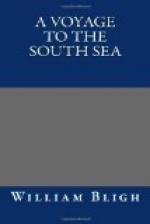I did not sail within less than six leagues of the coast that we might have the wind more regular and avoid being exposed to the heavy squalls that came off from the land. At noon Cape St. Anthony bore south and the westernmost of New Year’s Isles south-east one-quarter south, five or six leagues. Latitude observed 54 degrees 28 minutes south, longitude 64 degrees 4 minutes west.
The sight of New Year’s Harbour almost tempted me to put in; but the lateness of the season and the people being in good health determined me to lay aside all thoughts of refreshment until we should reach Otaheite. At two o’clock in the afternoon the easternmost of New Year’s Isles, where Captain Cook observed the latitude to be 55 degrees 40 minutes south, bore from us south four leagues. We saw the entrance isles of New Year’s harbour at the back of which the land is very craggy and mountainous. This must be a very convenient port to touch at as the access to it is safe and easy. The harbour lies south-south-east by compass from the north-east part of the easternmost of the New Year’s Islands.
About two leagues to the westward of Cape St. John I observed the separation of the mountains that Captain Cook has taken notice of, which has the appearance of Staten Land being there divided into two islands.
At sunset Cape St. John bore south-south-east five or six leagues. The land hereabouts is of less height and not so rugged as near New Year’s Harbour. The night coming on I could get no good view of the coast near the Cape; and at daylight next morning we were at too great a distance.
Monday 24.
We had stood to the southward all night with the wind at west-south-west and south-west. At eight in the morning Cape St. John bore north-west ten leagues distant. Soon after we lost sight of the land.
From the result of my lunar observations, assisted by the timekeeper, I make the longitude of the west side of Straits le Maire 64 degrees 48 minutes west; the easternmost of the New Year’s isles 63 degrees 52 minutes west; and the longitude of Cape St. John 63 degrees 19 minutes west.
In our run from the latitude of 12 degrees south to 48 degrees south the ship was set 2 degrees 30 minutes to the eastward by currents; and from the latitude of 48 degrees south to Staten Land the currents set us to the westward 2 degrees 43 minutes; which I imagine to have been occasioned by an indraught into the Straits of Magellan.
From the time we lost sight of the land to the end of the month we were struggling with bad weather and contrary winds.
Monday 31.
But on the morning of the 31st the wind came to the north-north-east and made us entertain great hopes that we should be able to accomplish our passage round the Cape without much difficulty. At noon we were in latitude 60 degrees 1 minute south and in 71 degrees 45 minutes west longitude, which is 8 degrees 26 minutes west of the meridian of Cape St. John. This flattering appearance was not of long continuance: in the night the wind became variable and next day settled again in the west and north-west with very bad weather.




